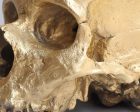Gold Neanderthal Skull – 2015 to 2018
24 Carat Gold, Bronze
Human skulls have often been used in art to illustrate impermanence, the vanity of earthly pursuits and the transient nature of life. The Memento Mori, from the Latin meaning ‘remember death’, has been found in many traditions of art, represented by a human skull.
Evidence would suggest that Neanderthals were not a primitive sub-species, but a highly evolved group with the capacity for self awareness and abstract thought. It would seem possible that Neanderthals were the first hominids to create symbolic works of art and to engage in ritualistic rites of passage. Yet the question of whether the Neanderthal was a separate species would remain. While Neanderthals were classified as either a a species or subspecies of Homo sapiens DNA mapping would illustrate that the Neanderthal could not be identified as a distinct, separate species.
The skulls classified as Neanderthal were far larger than that of a modern human, with a cavity carrying a significantly larger brain. The average modern adult human brain would weighs around 1.5 kg, or 3.3 lbs. Brain sizes could vary substantially from 974.9 to 1398.1 cm3 in women and 1052.9 to 1498.5 cm3 in men. Hominid brain size would change dramatically over time, with early examples of Homo habilis (thought to live approximately 2.8 to 1.4 million years ago) being around 600 cm3, and Homo neandertalensis (thought to live approximately (400,000 to 35,000 years ago years ago) being around 1600 cm3, the largest brain in the hominid line. (2)
Neanderthals were thought to be widespread across Europe and Western Asia from around 400,000 years ago. By 45,000 years ago populations of early Homo sapiens had migrated into Europe, the Near East, South and West Asia. Five thousand years later the Neanderthals were considered to be extinct. While evidence would increasingly contradict the idea of Neanderthals as a species in their own right, such narratives would support a hierarchical view of an anthropocentric universe.
1. The most complete Neanderthal skull held in a museum collection is La Ferrassie 1, from a male Neanderthal skeleton estimated to be 70–50,000 years old, in the Musée de l’Homme, Paris. It was discovered at the La Ferrassie site in France by Louis Capitan and Denis Peyrony in 1909. The skull is constructed from dozens of individual bone fragments, with the missing sections pieced together with lead.
2. Brain weight in relation to body weight is relatively large in modern humans, but brain size is not the only deciding factor when it comes to language development or flexible thought, with diet, culture, environmental pressures and usage all affecting the brain’s neuroplasticity.

